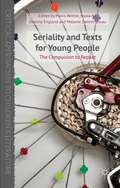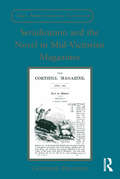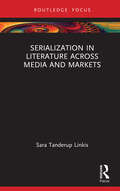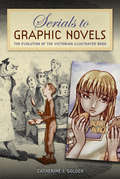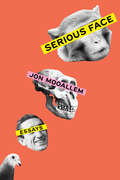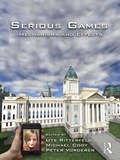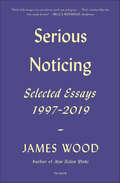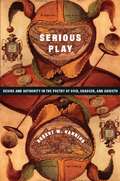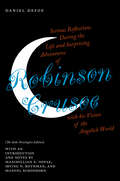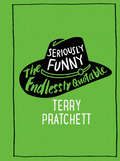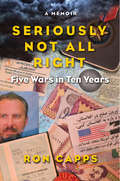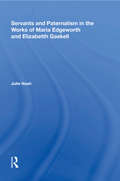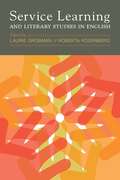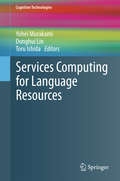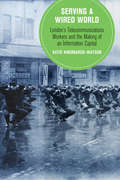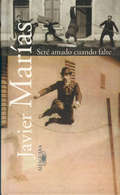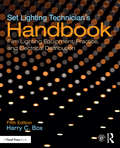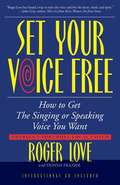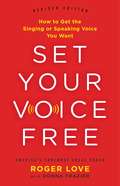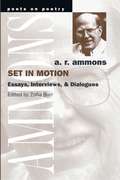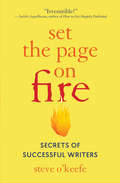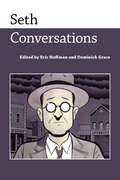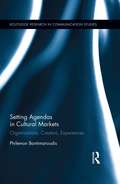- Table View
- List View
Seriality and Texts for Young People: The Compulsion to Repeat (Critical Approaches to Children's Literature)
by Melanie Dennis Unrau M. Reimer N. Ali D. England M. Dennis UnrauSeriality and Texts for Young People is a collection of thirteen scholarly essays about series and serial texts directed to children and youth, each of which begins from the premise that a basic principle of seriality is repetition.
Serialization and the Novel in Mid-Victorian Magazines (The Nineteenth Century Series)
by Catherine DelafieldExamining the Victorian serial as a text in its own right, Catherine Delafield re-reads five novels by Elizabeth Gaskell, Anthony Trollope, Dinah Craik and Wilkie Collins by situating them in the context of periodical publication. She traces the roles of the author and editor in the creation and dissemination of the texts and considers how first publication affected the consumption and reception of the novel through the periodical medium. Delafield contends that a novel in volume form has been separated from its original context, that is, from the pattern of consumption and reception presented by the serial. The novel's later re-publication still bears the imprint of this serialized original, and this book’s investigation into nineteenth-century periodicals both generates new readings of the texts and reinstates those which have been lost in the reprinting process. Delafield's case studies provide evidence of the ways in which Household Words, Cornhill Magazine, Good Words, All the Year Round and Cassell's Magazine were designed for new audiences of novel readers. Serialization and the Novel in Mid-Victorian Magazines addresses the material conditions of production, illustrates the collective and collaborative creation of the serialized novel, and contextualizes a range of texts in the nineteenth-century experience of print.
Serialization in Literature Across Media and Markets
by Sara Tanderup LinkisSerialization is an old narrative strategy and a form of publication that can be traced far back in literary history, yet serial narratives are as popular as ever. This book investigates a resurgence of serial narratives in contemporary literary culture. Analyzing series as diverse as Mark Z. Danielewski’s experimental book series The Familiar; audiobook series by the Swedish streaming service Storytel; children’s books by Lemony Snicket and Philip Pullman and their adaptations into screen; and serial writing and reading on the writing site Wattpad, the book traces how contemporary series at once are shaped by literary tradition and develop the format according to the logics of new media and digital technologies. The book sheds light on the interplay between the selected serials' narrative content and medial, social, and economic contexts, drawing on insights from literary studies, literary sociology, media studies, and cultural studies. Serialization in Literature Across Media and Markets thus contributes a unique and interdisciplinary perspective on a historical phenomenon that has proved ever more successful in contemporary media culture. It is a book for researchers and students of literature and media and for anyone who likes a good series and wants to understand why.
Serialization in Popular Culture (Routledge Research in Cultural and Media Studies)
by Rob Allen Thijs van den BergFrom prime-time television shows and graphic novels to the development of computer game expansion packs, the recent explosion of popular serials has provoked renewed interest in the history and economics of serialization, as well as the impact of this cultural form on readers, viewers, and gamers. In this volume, contributors—literary scholars, media theorists, and specialists in comics, graphic novels, and digital culture—examine the economic, narratological, and social effects of serials from the nineteenth to the twenty-first century and offer some predictions of where the form will go from here.
Serials to Graphic Novels: The Evolution of the Victorian Illustrated Book
by Catherine J. GoldenThe Victorian illustrated book came into being, flourished, and evolved during the long nineteenth century. While existing scholarship on Victorian illustrators largely centers on the realist artists of the "Sixties," this volume examines the entire lifetime of the Victorian illustrated book. Catherine Golden offers a new framework for viewing the arc of this vibrant genre, arguing that it arose from and continually built on the creative vision of the caricature-style illustrators of the 1830s. She surveys the fluidity of illustration styles across serial installments, British and American periodicals, adult and children’s literature, and--more recently--graphic novels. Serials to Graphic Novels examines widely recognized illustrated texts, such as The Pickwick Papers, Oliver Twist, Alice in Wonderland, Peter Rabbit, and Trilby. Golden explores factors that contributed to the early popularity of the illustrated book—the growth of commodity culture, a rise in literacy, new printing technologies—and that ultimately created a mass market for illustrated fiction. Golden identifies present-day visual adaptations of the works of Austen, Dickens, and Trollope as well as original Neo-Victorian graphic novels like The League of Extraordinary Gentlemen and Victorian-themed novels like Batman: Noël as the heirs to the Victorian illustrated book. With these adaptations and additions, the Victorian canon has been refashioned and repurposed visually for new generations of readers.
Serious Face: Essays
by Jon MooallemFrom the discovery of the author&’s face in a century-old photograph to a triple-amputee hospice director working at the border of life and death, here are thirteen hopeful, heartbreaking, and profound essays from &“one of the most intelligent, compassionate, and curious authors working today&” (Elizabeth Gilbert). ONE OF THE MOST ANTICIPATED BOOKS OF 2022—Lit HubBeneath the self-assured and serious faces we wear, every human life is full of longing, guesswork, and confusion—a scramble to do the best we can and make everything up as we go along. In these wide-ranging essays, Jon Mooallem chronicles the beauty of our blundering and the inescapability of our imperfections. He investigates the collapse of a multimillion-dollar bird-breeding scam run by an aging farmer known as the Pigeon King, intimately narrates a harrowing escape from California&’s deadliest wildfire, visits an eccentric Frenchman building a town at what he claims is the center of the world, shadows a man through his first day of freedom after twenty-one years in prison, and more—all with a deep conviction that it&’s our vulnerability, not our victories, that connect us.Mooallem&’s powers of perception have established him as one of the most distinctive, empathic, and clear-sighted narrative journalists working today. The Wall Street Journal has called his writing &“as much art as it is journalism,&” and Jia Tolentino has praised his &“grace and command.&” In Serious Face, Mooallem brings to life the desperate hopes and urgent fears of the people he meets, telling their stories with empathy, humor, insight, and kindness. These elegant, moving essays form an idiosyncratic tapestry of human experience: our audacity and fallibility, our bumbling and goodwill. In moments of calamity and within the extreme absurdity of everyday life, can we learn to love the people we really are, behind the serious faces we show the world?
Serious Games: Mechanisms and Effects
by Michael Peter Vorderer Ritterfeld Ute CodySerious Games provides a thorough exploration of the claim that playing games can provide learning that is deep, sustained and transferable to the real world. "Serious games" is defined herein as any form of interactive computer-based game software for one or multiple players to be used on any platform and that has been developed to provide more than entertainment to players. With this volume, the editors address the gap in exisiting scholarship on gaming, providing an academic overview on the mechanisms and effects of serious games. Contributors investigate the psychological mechanisms that take place not only during gaming, but also in game selection, persistent play, and gaming impact. The work in this collection focuses on the desirable outcomes of digital game play. The editors distinguish between three possible effects -- learning, development, and change -- covering a broad range of serious games’ potential impact. Contributions from internationally recognized scholars focus on five objectives: Define the area of serious games Elaborate on the underlying theories that explain suggested psychological mechanisms elicited through serious game play, addressing cognitive, affective and social processes Summarize the empirical evidence on the effectiveness of serious games, Introduce innovative research methods as a response to methodological challenges imposed through interactive media Discuss the possibilities and limitations of selected applications for educational purposes. Anchored primarily in social science research, the reader will be introduced to approaches that focus on the gaming process and the users’ experiences. Additional perspectives will be provided in the concluding chapters, written from non-social science approaches by experts in academic game design and representatives of the gaming industry. The editors acknowledge the necessity for a broader interdisciplinary study of the phenomena and work to overcome the methodological divide in games research to look ahead to a more integrated and interdisciplinary study of digital games. This timely and singular volume will appeal to scholars, researchers, and graduate students working in media entertainment and game studies in the areas of education, media, communication, and psychology.
Serious Noticing: Selected Essays, 1997–2019
by James WoodThe definitive collection of literary essays by The New Yorker’s award-winning longtime book criticEver since the publication of his first essay collection, The Broken Estate, in 1999, James Wood has been widely regarded as a leading literary critic of the English-speaking world. His essays on canonical writers (Gustav Flaubert, Herman Melville), recent legends (Don DeLillo, Marilynne Robinson) and significant contemporaries (Zadie Smith, Elena Ferrante) have established a standard for informed and incisive appreciation, composed in a distinctive literary style all their own.Together, Wood’s essays, and his bestselling How Fiction Works, share an abiding preoccupation with how fiction tells its own truths, and with the vocation of the writer in a world haunted by the absence of God. In Serious Noticing, Wood collects his best essays from two decades of his career, supplementing earlier work with autobiographical reflections from his book The Nearest Thing to Life and recent essays from The New Yorker on young writers of extraordinary promise. The result is an essential guide to literature in the new millennium.
Serious Play: Desire and Authority in the Poetry of Ovid, Chaucer, and Ariosto (Leonard Hastings Schoff Lectures)
by Robert HanningOvid, Chaucer, and Ariosto, premodern Europe's three greatest comic poets, found abundant cause for laughter in the foibles and follies of human desire. Yet they also excelled at the dangerous game of skewering the elites on whom they depended for patronage. The resulting depictions of addled lovers and rattled rulers create a unique dynamic of trenchant critique wrapped in amusing, enlightening, and disturbing fantasy, an achievement hailed as serio ludere, serious play, by Renaissance theorists.Through an imaginative analysis of Ovid's amatory poetry, Chaucer's dream poems and excerpts from the Canterbury Tales, and Ariosto's epic Orlando Furioso, Robert W. Hanning illuminates the contrast and continuities in often hilarious, always empathetic representations of bungled desire and thwarted political authority. He also documents the response of all three poets to the "authority" of cultural predecessors and poetic convention. Each poet lived through exciting times (Augustan Rome, late-medieval London, and high-Renaissance Italy, respectively) and their outsider-insider status links them as memorable speakers of comedic truth to power. Providing fresh perspectives on Ovid, Chaucer, and Ariosto within their rich historical moments, Serious Play isolates the elements that make their work so appealing centuries after they lived, observed, and wrote.
Serious Reflections During the Life and Surprising Adventures of Robinson Crusoe with his Vision of the Angelick World: The Stoke Newington Edition
by Daniel Defoe DefoeSerious Reflections During the Life and Surprising Adventures of Robinson Crusoe with his Vision of the Angelick World, first published in 1720 and considered a sequel to The Farther Adventures of Robinson Crusoe, is a collection of essays written in the voice of the Crusoe character. Expressing Defoe’s thoughts about many moral questions of the day, the narrator takes up isolation, poverty, religious liberty, and epistemology. Defoe also used this volume to revive his interest in poetry, not the satiric poetry of the early eighteenth century, but the more inspirational verse that appeared in some of his later works. Serious Reflections also includes an imaginative flight in which Crusoe wanders among the planets, a return to the moon voyage impulse of Defoe’s 1705 work The Consolidator. Illuminating the ideas and philosophy of this most influential of English novelists, it is invaluable for any student of the period.
Seriously Funny: The Endlessly Quotable Terry Pratchett
by Terry Pratchett‘I’ll be more enthusiastic about encouraging thinking outside the box when there’s evidence of any thinking going on inside it.’The most quotable writer of our time, Terry Pratchett’s unique brand of wit made him both a bestseller and an enduring, endearing source of modern wisdom. This collection is filled with his funniest and most memorable words about life, the universe and snoring.
Seriously Not All Right: Five Wars in Ten Years
by Ron CappsFor more than a decade, Ron Capps, serving as both a senior military intelligence officer and as a Foreign Service officer for the U.S. Department of State, was witness to war crimes, ethnic cleansing, and genocide. From government atrocities in Kosovo, to the brutal cruelties perpetrated in several conflicts in central Africa, the wars in both Aghanistan and Iraq, and culminating in genocide in Darfur, Ron acted as an intelligence collector and reporter but was diplomatically restrained from taking preventative action in these conflicts. The cumulative effect of these experiences, combined with the helplessness of his role as an observer, propelled him into a deep depression and a long bout with PTSD, which nearly caused him to take his own life. Seriously Not All Right is a memoir that provides a unique perspective of a professional military officer and diplomat who suffered (and continues to suffer) from PTSD. His story, and that of his recovery and his newfound role as founder and teacher of the Veterans Writing Project, is an inspiration and a sobering reminder of the cost of all wars, particularly those that appeared in the media and to the general public as merely sidelines in the unfolding drama of world events.
Servants and Paternalism in the Works of Maria Edgeworth and Elizabeth Gaskell (The\nineteenth Century Ser.)
by Julie NashWriting during periods of dramatic social change, Maria Edgeworth and Elizabeth Gaskell were both attracted to the idea of radical societal transformation at the same time that their writings express nostalgia for a traditional, paternalistic ruling class. The author shows how this tension is played out especially through the characters of servants in short fiction and novels such as Edgeworth's Castle Rackrent, Belinda, and Helen and Gaskell's North and South and Cranford. Servant characters, the author contends, enable these writers to give voice to the contradictions inherent in the popular paternalistic philosophy of their times because the situation of domestic servitude itself embodies such inconsistencies. Servants, whose labor was essential to the economic and social function of eighteenth- and nineteenth-century British society, made up the largest category of workers in England by the nineteenth century and yet were expected to be socially invisible. At the same time, they lived in the same houses as their masters and mistresses and were privy to the most intimate details of their lives. Both Edgeworth and Gaskell created servant characters who challenge the social hierarchy, thus exposing the potential for dehumanization and corruption inherent in the paternalistic philosophy. the author's study opens up important avenues for future scholars of women's fiction in the nineteenth century.
Service Learning and Literary Studies in English
by Laurie Grobman and Roberta RosenbergService learning can help students develop a sense of civic responsibility and commitment, often while addressing pressing community needs. One goal of literary studies is to understand the ethical dimensions of the world, and thus service learning, by broadening the environments students consider, is well suited to the literature classroom. Whether through a public literacy project that demonstrates the relevance of literary study or community-based research that brings literary theory to life, student collaboration with community partners brings social awareness to the study of literary texts and helps students and teachers engage literature in new ways.In their introduction, the volume editors trace the history of service learning in the United States, including the debate about literature's role, and outline the best practices of the pedagogy. The essays that follow cover American, English, and world literature; creative nonfiction and memoir; literature-based writing; and cross-disciplinary studies. Contributors describe a wide variety of service-learning projects, including a course on the Harlem Renaissance in which students lead a community writing workshop, an English capstone seminar in which seniors design programs for public libraries, and a creative nonfiction course in which first-year students work with elderly community members to craft life narratives. The volume closes with a list of resources for practitioners and researchers in the field.
Service Workers
by Marianne LenihanThe fun and excitement of English and Language Arts learning continues in Grade 2 of Reading Street. This comprehensive and dynamic curriculum for homeschooling is geared toward young children who have some foundational English and Language Arts knowledge and are ready to strengthen their skills. Comprised of engaging activities, challenging content and weekly quizzes, Reading Street: Grade 2 is the next step in your child's path toward becoming a lifelong learner and reader. As with all Reading Street products, the Grade 2 system is formatted to help students meet certain age-appropriate goals. After completing this English and Language Arts homeschool program, your child should be able to: Read and comprehend two-syllable words. Identify common prefixes (such as pre-, un-, or re-) and suffixes (such as -able, -ad and -er). Correct mistakes made when reading out loud. Read books with two or more chapters. Understand the structure of stores (i. e. beginning, middle and end). Start selecting reading materials based on his/her own interests. Identify the "who," "what," "when," "where," "why" and "how" of the text. While the goals of second Grade English and Language Arts are numerous, Reading Street will help you craft engrossing lessons. Your child will garner important English and Language Arts skills while completing a workbook, reading stories and poems, and taking assessments. Planning these lessons will be easier than ever, as all Reading Street systems are broken down into weekly Big Ideas. All the work your child does on a given week is formulated around that single concept for an organized and challenging curriculum. With six easy-to-follow units, Reading Street: Grade 2 is the perfect tool for homeschooling parents. Your child will enjoy the reading selections and activities, and you'll love to see your student growing into a knowledgeable individual. We're confident that this product is the right one for you. For more information on the specific materials found in Grade 2 of Reading Street, check out the Features and Benefits page.
Services Computing for Language Resources (Cognitive Technologies Ser.)
by Yohei Murakami Donghui Lin Toru IshidaDescribing the technologies to combine language resources flexibly as web services, this book provides valuable case studies for those who work in services computing, language resources, human–computer interaction (HCI), computer-supported cooperative work (CSCW), and service science. The authors have been operating the Language Grid, which wraps existing language resources as atomic language services and enables users to compose new services by combining them. From architecture level to service composition level, the book explains how to resolve infrastructural and operational difficulties in sharing and combining language resources, including interoperability of language service infrastructures, various types of language service policies, human services, and service failures.The research based on the authors’ operating experiences of handling complicated issues such as intellectual property and interoperability of language resources contributes to exploitation of language resources as a service. On the other hand, both the analysis based on using services and the design of new services can bring significant results. A new style of multilingual communication supported by language services is worthy of analysis in HCI/CSCW, and the design process of language services is the focus of valuable case studies in service science. By using language resources in different ways based on the Language Grid, many activities are highly regarded by diverse communities.This book consists of four parts: (1) two types of language service platforms to interconnect language services across service grids, (2) various language service composition technologies that improve the reusability, efficiency, and accuracy of composite services, (3) research work and activities in creating language resources and services, and (4) various applications and tools for understanding and designing language services that well support intercultural collaboration.
Serving a Wired World: London's Telecommunications Workers and the Making of an Information Capital (Berkeley Series in British Studies #17)
by Katie Hindmarch-WatsonIn the public imagination, Silicon Valley embodies the newest of the new—the cutting edge, the forefront of our social networks and our globally interconnected lives. But the pressures exerted on many of today’s communications tech workers mirror those of a much earlier generation of laborers in a very different space: the London workforce that helped launch and shape the massive telecommunications systems operating at the turn of the twentieth century. As the Victorian age ended, affluent Britons came to rely on information exchanged along telegraph and telephone wires for seamless communication: an efficient and impersonal mode of sharing thoughts, demands, and desires. This embrace of seemingly unmediated communication obscured the labor involved in the smooth operation of the network, much as our reliance on social media and app interfaces does today.Serving a Wired World is a history of information service work embedded in the daily maintenance of liberal Britain and the status quo in the early years of the twentieth century. As Katie Hindmarch-Watson shows, the administrators and engineers who crafted these telecommunications systems created networks according to conventional gender perceptions and social hierarchies, modeling the operation of the networks on the dynamic between master and servant. Despite attempts to render telegraphists and telephone operators invisible, these workers were quite aware of their crucial role in modern life, and they posed creative challenges to their marginalized status—from organizing labor strikes to participating in deviant sexual exchanges. In unexpected ways, these workers turned a flatly neutral telecommunications network into a revolutionary one, challenging the status quo in ways familiar today.
Seré amado cuando falte
by Javier Marías«Este libro es la prolongación literal de otro que publiqué en 1997, Mano de sombra. Si aquel volumen recogía ciento cuatro artículos, correspondientes a dos años de tarea, el presente reúne veinticuatro meses más de opiniones sin cuento... Me despedí entonces diciendo que al releer todas las piezas seguidas había tenido la impresión de haber opinado demasiado. Así que imagínense ahora, tras otras ciento cuatro. No sé cómo nadie consiente, tras tanto tiempo, que le siga reventando los domingos.» Así dice Javier Marías en el preámbulo a Seré amado cuando falte. Pero quizá hay que concederle más crédito en otro sitio: «No me gusta el proselitismo y aún menos el espíritu evangélico, veo ambas cosas como una forma de violentar las creencias y las voluntades. Es arriesgado que diga esto quien escribe una columna dominical desde hace años, pero, si no me equivoco en exceso, y aunque mis argumentaciones sean a veces vehementes, creo que no pretenden tanto convencer a los lectores para que se adhieran a ellas o adopten ciertos comportamientos cuanto que las tengan en cuenta y se paren a pensar un rato con la perspectiva de otro a quien no suele bastar lo que la mayoría piensa o, como lo he expresado otras veces, lo que ya piensa la época de nosotros.»
Set Lighting Technician's Handbook: Film Lighting Equipment, Practice, and Electrical Distribution
by Harry C. BoxA friendly, hands-on training manual and reference for lighting technicians in motion picture and television production, this handbook is the most comprehensive guide to set lighting available. It provides a unique combination of practical detail with a big-picture understanding of lighting, technology, safety, and professionalism, essential to anyone doing motion picture lighting. The fifth edition delves into every aspect of lighting and features vastly expanded sections on controlling LED lights, color science, lighting control systems, wireless systems, Ethernet-based control systems, battery power, and modern set protocol for productions small and large. With a generous number of original images, the book illustrates the use of soft light, the effect of lighting angles, and how the gaffer and DP build an effective lighting plan around the blocking of the actors. This encyclopedic volume of technical knowhow is tempered with years of practical experience and a much-needed sense of humor.This is the ideal text for professional lighting technicians across film and television including lighting directors, gaffers, DOPs, and rigging crews, as well as film and television production students studying lighting, camera techniques, film production, and cinematography.It includes a revamped companion website with supplementary resources, forms, checklists, and images.
Set Your Voice Free
by Roger Love Donna FrazierInternationally acclaimed for his work as a vocal coach to a wide range of top recording artists and celebrities -- among them Eminem, Wilson Phillips, Smashing Pumpkins, Al Jarreau, the Beach Boys, Phish, Billy Idol, Tyra Banks, Billy Baldwin, Alicia Silverstone, and many others -- Roger Love has pioneered a technique that effectively connects speakers and singers to parts of their voice they've never used before. Whether your goal is to carry a tune, expand your vocal range, or speak with ease and confidence before an audience, Roger Love provides you with exactly the help you need. Through the innovative techniques and enjoyable exercises in this book and accompanying CD, Love demonstrates how you can strengthen your "middle voice" and navigate smoothly through several octaves without pressure or strain. Set Your Voice Free holds the key to vocal success and satisfaction -- it's like professional voice lessons in book form.
Set Your Voice Free: How to Get the Singing or Speaking Voice You Want
by Roger Love Donna FrazierThe greatest vocal coach in the world will help you get the voice you want. Every time we open our mouths, we have an effect on ourselves and the way others perceive us. The ability to speak clearly and confidently can make or break a presentation, an important meeting, or even a first date. Now, with the advent of Skype, YouTube, podcasting, Vine, and any number of reality talent competitions, your vocal presence has never been more necessary for success or more central to achieving your dreams.Roger Love has over 30 years of experience as one of the world's leading authorities on voice. Making use of the innovative techniques that have worked wonders with his professional clients, Love distills the best of his teaching in SET YOUR VOICE FREE, and shares exercises that will help readers bring emotion, range, and power to the way they speak.This updated edition incorporates what he's learned in the last 15 years as the Internet and talent competitions have completely changed the role your voice plays in your life. These are the new essentials for sounding authentic, persuasive, distinctive, and real in a world that demands nothing less.
Set in Motion
by Zofia BurrSet in Motioncollects for the first time the prose writings of A. R. Ammons, one of our most important and enduring contemporary poets. Hailed as a major force in American poetry by such redoubtable critics as Harold Bloom and Helen Vendler, Ammons has reflected upon the influences of luminaries like Emerson, Thoreau, Whitman, Frost, Stevens, and Williams while creating a compelling style and an artistic vision uniquely his own. Set in Motionincludes essays, reviews, and interviews as well as a selection of Ammons's poems, with commentary from the author about their inspiration and effects. He takes up the questions that have been central to American poetry over the last forty years and connects them to the larger enterprise of living in a difficult, changing world. At a moment when the arts are under attack, Ammons reminds us of the crucial role poetry plays in teaching us to recognize and use sources of understanding that are irreducible to statement. A. R. Ammons is the author ofSphere, A Coast of Trees,andGarbageand was recently the editor ofThe Best American Poetry 1994. His awards include the MacArthur and Guggenheim fellowships, the Bollingen Prize, two National Book Awards, and prizes from the American Academy of Arts and Letters and the National Book Critics Circle. He is Goldwin Smith Professor of Poetry, Cornell University.
Set the Page on Fire: Secrets of Successful Writers
by Steve O'KeefeDiscover the Tricks and Tools of the Pros Successful writers write, rather than just think about writing, talk about writing, or plan what they&’ll write when they get a cabin in the woods. Yet even accomplished writers sometimes get &“blocked,&” losing access to their in-the-zone writing mind. Steve O&’Keefe offers proven techniques and practices for jump-starting stalled ideas, honed during his many years of working in virtually every aspect of publishing. His innovative, often unconventional exercises will get you writing and accessing your own unique voice — a voice the world wants to read! Containing a career&’s worth of writing and publishing savvy, as well as the advice of expert authors gleaned from hundreds of interviews, Set the Page on Fire is the kind of nuts-and-bolts coaching and encouragement invaluable to novice and veteran writers alike.
Seth: Conversations (Conversations with Comic Artists Series)
by Eric Hoffman Dominick GraceCanadian cartoonist Gregory Gallant, pen name Seth, emerged as a cartoonist in the fertile period of the 1980s, when the alternative comics market boomed. Though he was influenced by mainstream comics in his teen years and did his earliest comics work on Mister X, a mainstream-style melodrama, Seth remains one of the least mainstream-inflected figures of the alternative comics' movement. His primary influences are underground comix, newspaper strips, and classic cartooning. These interviews, including one career-spanning, definitive interview between the volume editors and the artist published here for the first time, delve into Seth's output from its earliest days to the present. Conversations offer insight into his influences, ideologies of comics and art, thematic preoccupations, and major works, from numerous perspectives—given Seth's complex and multifaceted artistic endeavors. Seth's first graphic novel, It's a Good Life, If You Don't Weaken, announced his fascination with the past and with earlier cartooning styles. Subsequent works expand on those preoccupations and themes. Clyde Fans, for example, balances present-day action against narratives set in the past. The visual style looks polished and contemplative, the narrative deliberately paced; plot seems less important than mood or characterization, as Seth deals with the inescapable grind of time and what it devours, themes which recur to varying degrees in George Sprott, Wimbledon Green, and The Great Northern Brotherhood of Canadian Cartoonists.
Setting Agendas in Cultural Markets: Organizations, Creators, Experiences (Routledge Research in Communication Studies)
by Philemon BantimaroudisThis book draws on agenda setting theory to examine how cultural organizations relate to media in order to increase their visibility, valence, and eventually build their public image. Most organizations have a keen interest in their symbolic presence, as their media visibility influences public knowledge, perceptions and even behaviors. Diminished public funding, in combination with the global proliferation of cultural entities, creates a competitive environment, leading to a transformation of cultural industries. In the book, several questions are under scrutiny: How do cultural organizations acquire symbolic significance? How do they become prominent in media content? Which mechanisms and processes should be examined by cultural managers as they set out to achieve salience? Is there a relationship between media and public salience? In other words, if an organization becomes symbolically prominent, in what ways is the public influenced, both in terms of perceptions as well as behaviors?
